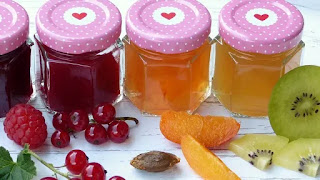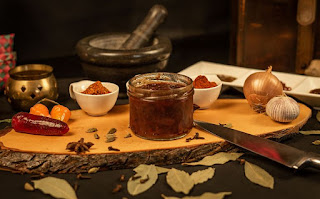One of the cardinal rules of blogging is
to get and keep your readers’ attention with an attention-grabbing headline. Hence my title this week. Welcome.
Autumn is the busy season for the jelly, chutney and preserve makers amongst us. Out comes the River Cottage Book of Preserves by Pam the Jam and a strange and arcane selection of equipment. Maslin pans. Ladles. Spouts and funnels. Muslin. Any jelly maker worth their salt will be off foraging for free hedgerow ingredients.
My favourite jelly is crab apple. It's incredibly easy to make. You pick crab apples and give them a bit of a wash under the tap. You put them in a pan with some water and stew them for a bit. Then you strain the pulp through muslin. In the morning, you’ve got a pan full of syrup which you boil vigorously with sugar. The resulting jelly is a charming pale pink and goes incredibly well with cheese.
Wild apple trees are often covered with
shiny, glossy fruit which simply cries out to be picked. Blackberry bushes are
bejewelled with their little black treasures. Crab apples are small, scabby,
misshapen and gnarled. They don’t exactly fill you with confidence.
I haven’t been able to find any crab
apples since we moved to Suffolk. I appealed on Facebook in August and got
three replies. (Thanks Carolyn, Nicola and Pat). Earlier this week, on one of the
last days of summer, Mr Leigh and myself went down to our neighbour’s farm armed
with a tub and some cardboard boxes. It was a beautiful day. The sun glanced
coyly through thick growing trees, casting dappled shade on the ground. As we followed
Carolyn to the site of the crab apples, bouncing along on the rutted track, we
seemed to be leaving the 21st century behind and meandering back
into a quieter, kinder time. Carolyn left us to it and we stood gazing at the
branches of the intertwined trees loaded with fruit.
For an hour or so, we picked crab apples
while birds sang. It was idyllic. The peace and quiet was only punctuated by
helicopters flying low overhead (we live near an Army base) and muffled cries of
pain as we stung ourselves on nettles and caught ourselves on brambles.
I couldn’t tell you how many pounds we picked. Enough to make crab apple jelly to feed an army, for sure. Driving slowly back as the sun slid languorously down in the sky and the shadows lengthened, I gazed out of the car window at the gentle inclines of rich red Suffolk soil and thought about how something which looks completely unprepossessing can be so filled with goodness.
You can’t eat crab apples raw unless you want to take the roof of your mouth off. They’re sour and inedible. They’re not going to win any beauty contests. Once you soften them up and add sugar, however, they’re transformed into a shimmering rose-coloured jelly.Sixteen years ago, I was fairly
unprepossessing myself. If you’d told me that I’d be living in this beautiful
place with all of Nature’s bounty on my doorstep, I’d have laughed in your face.
I needed to be softened up and sweetened a bit.
So, now I’ve got crabs and by the end of
the week, I should have plenty more. I’m in my element, taking something which
doesn’t look that nice and transforming it into something beautiful. Jelly
making is a mixture of alchemy, chemistry and a sprinkling of magic. It’s good
for the soul and pretty beneficial to the larder too.
Images by Pixabay
Ruth is a freelance writer and novelist.
She is married with three children, one husband, four budgies, six quail, eight
chickens and a kitten. Her first novel, “The Diary of Isabella M Smugge”,
published by Instant Apostle, comes out in March 2021. She writes for a number
of small businesses and charities and blogs at Big Words and Made Up Stories. Ruth
is a recovering over-achiever who is now able to do the school run in her
onesie most days. She has abnormally narrow sinuses and a morbid fear of raw
tomatoes, but has decided not to let this get in the way of a meaningful life.
You can find her on Instagram and Twitter at ruththewriter1.














